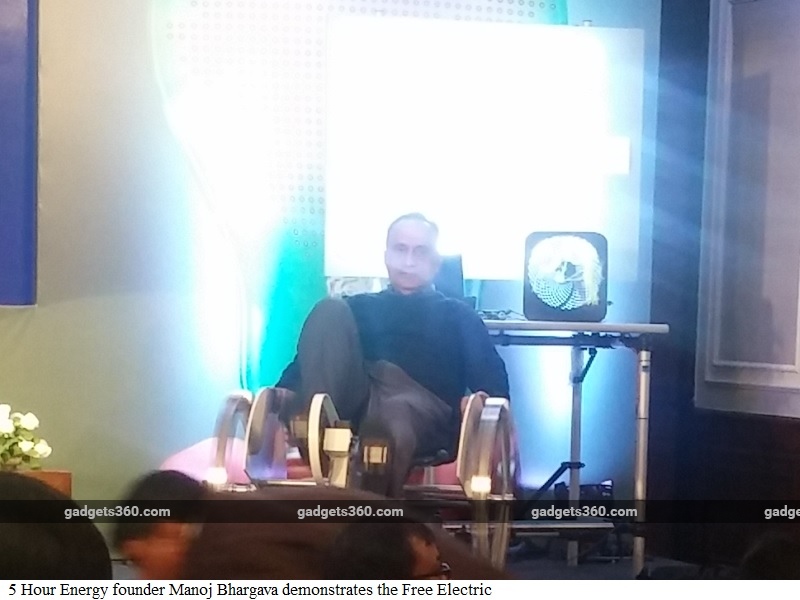- Home
- Others
- Others Features
- From 5 Hour Energy to 24 Hour Electricity, With Free Electric
From 5-Hour Energy to 24 Hour Electricity, With Free Electric

Indian-American businessman Manoj Bhargava might well be the patron saint of employees with long working hours and students cramming for exams as the creator of 5-hour Energy, an "energy shot" brand, but in interviews, he's talked about wanting to invest his fortune to make a difference in the developing world. Last Friday, Bhargava was in Delhi to launch Free Electric, a stationary bicycle whose buyers can use it to generate electricity.
"One of the biggest problems in India right now is the lack of electricity," says Bhargava, speaking to Gadgets 360 at the launch event for Free Electric. "When you're pedalling this, you can power 24 LED bulbs, a fan, a phone charger, and a tablet - or you can use it to charge a battery, which can be used to power your household needs," he adds.
Bhargava's Stage 2 Innovations, a specialised laboratory working on problems related to water, energy, and health, has created a design, which will be licensed out to partners and sold to people in rural areas and to the urban poor, for whom he believes ready access to energy is going to be a revolutionary change.
"The idea was to make something that was really simple - if someone can fix a bicycle, he can fix this," says Bhargava, adding, "the problem with solar is that it can't be fixed in a village. Children throw stones, we have monkeys, and the weather is such that you can go a week without sun, so solar isn't really well suited to India."
The company started working on the project a little over two years ago, and went through many failed designs along the way. Bhargava tells Gadgets 360 that one of the early designs was to make a hand cranked generator, that would look similar to a water hand-pump - the idea being that this electricity pump would be instantly familiar, and therefore easily adopted. However, the concept was a bust, and along the way, there were plenty of other setbacks, until the pedal design was adopted.
The Free Electric cycle will go into production from March 2016, says Bhargava, but he refused to share details about the partners who will be manufacturing and distributing the cycle in India. However, he says that it will be sold and distributed through existing distribution channels, instead of relying on non-profits or the government.
"They [non-profits] are really bad, they're only a little better than the government when it comes to getting efficient logistics done," he says. Of course, relying on commercial channels means that there is a higher cost involved, even if Bhargava says he isn't looking to make a profit on the device; it will cost the end user between Rs. 12,000 and Rs. 15,000. That might not sound like much at a time when we're looking at smartphones priced at over Rs. 50,000, but Bhargava isn't trying to sell these bikes to most people.
"This is not really useful if you have an AC or a fridge," he points out. "You might not think that you're rich, but compared to the people living in villages, you are very rich." The people who will most benefit from the Free Electric are the ones for whom Rs. 12,000 poses a serious investment. But Bhargava is confident that there will be enough people to buy the bicycle.
"The bottom 200 million can't afford this, but there are 400 million people who don't have access to electricity, who can afford this," he says. "That's the first step, to get these devices to as many people as we can, and then we can address the rest."
"Also, it's not just for the home, it could also be for communities," he adds. "For example, a school could buy it, or small businesses Or perhaps someone could buy the cycle, while others in the community buy batteries, and then pay the guy with the cycle to use it to charge their batteries."
This kind of community model has already been tried by non-profits working on similar systems, but Bhargava is dismissive, talking about the efficiency of the Free Electric, and of the free market, in generating more energy, and delivering more units.
However, he's not sharing technical details about the bicycle, or sharing targets in terms of units to ship, total number of partners, or other specific details either.
"I'm not interested in watts and volts, I tell my engineers, 'tell me how many bulbs that is,' because that's what our buyers will understand," says Bhargava. He claims that an hour of pedalling should cover the needs of an average household, running a pair of bulbs for around six hours, along with charging up a mobile phone completely. "Of course, I have a bad feeling that lots of people will use this for TV too," he says.
Still, with new designs in the works for agricultural use, and a high end version of the Free Electric to sell in Western markets, whose sales will subsidise the rural version, it's clear that Bhargava has big plans, for India and the rest of the developing world, and these are going to get field tested pretty soon, starting in Uttarakhand.
Catch the latest from the Consumer Electronics Show on Gadgets 360, at our CES 2026 hub.
- Samsung Galaxy Unpacked 2025
- ChatGPT
- Redmi Note 14 Pro+
- iPhone 16
- Apple Vision Pro
- Oneplus 12
- OnePlus Nord CE 3 Lite 5G
- iPhone 13
- Xiaomi 14 Pro
- Oppo Find N3
- Tecno Spark Go (2023)
- Realme V30
- Best Phones Under 25000
- Samsung Galaxy S24 Series
- Cryptocurrency
- iQoo 12
- Samsung Galaxy S24 Ultra
- Giottus
- Samsung Galaxy Z Flip 5
- Apple 'Scary Fast'
- Housefull 5
- GoPro Hero 12 Black Review
- Invincible Season 2
- JioGlass
- HD Ready TV
- Laptop Under 50000
- Smartwatch Under 10000
- Latest Mobile Phones
- Compare Phones
- OPPO Reno 15 Pro Max
- Honor Win RT
- Honor Win
- Xiaomi 17 Ultra Leica Edition
- Xiaomi 17 Ultra
- Huawei Nova 15
- Huawei Nova 15 Pro
- Huawei Nova 15 Ultra
- Asus ProArt P16
- MacBook Pro 14-inch (M5, 2025)
- OPPO Pad Air 5
- Huawei MatePad 11.5 (2026)
- Xiaomi Watch 5
- Huawei Watch 10th Anniversary Edition
- Acerpure Nitro Z Series 100-inch QLED TV
- Samsung 43 Inch LED Ultra HD (4K) Smart TV (UA43UE81AFULXL)
- Asus ROG Ally
- Nintendo Switch Lite
- Haier 1.6 Ton 5 Star Inverter Split AC (HSU19G-MZAID5BN-INV)
- Haier 1.6 Ton 5 Star Inverter Split AC (HSU19G-MZAIM5BN-INV)












